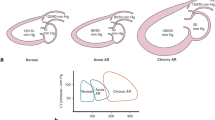Abstract
This study was designed to evaluate risk factors for in-hospital mortality and midterm survival in patients undergoing ascending aorta surgery at a single institution during an 11-year period. Between 1984 and 1994 a total of 158 patients underwent an ascending aorta procedure at our institution. Their mean age was 59.6 ± 12.3; 115 (73%) were male, 33 (21%) had a history of congestive heart failure, 61 (39%) had an acute type A dissection, 21 (13%) underwent redo operations, and 55 (35%) were operated on an emergency basis. In-hospital mortality was 9.7% (10/103) for elective procedures and 36.4% (20/55) for emergency operations ( p < 0.0001). Multivariable stepwise logistic regression analysis identified the cardiopulmonary bypass time [odds ratio (OR) = 1.01/min, p = 0.0021], emergency operation (OR = 2.27, p = 0.0022), arch replacement (OR = 2.71, p = 0.0067), and the need of femoral vein cannulation at intervention (OR = 1.89, p = 0.0375) as independent predictors of in-hospital death. When this kind of analysis was performed, evaluating only the variables known before surgery, acute type A dissection (OR = 2.21, p = 0.0009) and preoperative NYHA class (OR = 1.88 per class, p = 0.0290) were independent risk factors for in-hospital death. Follow-up ranged from 10 to 126 months (median 42 months), with Kaplan-Meier survivals of 69 ± 4%, and 60 ± 5% at 5 and 7 years, respectively; survival rates for hospital survivors were 85 ± 4% and 67 ± 7% at 5 and 7 years, respectively. Cox regression analysis has identified arch replacement [relative risk (RR) = 2.48, p < 0.0001], perioperative myocardial infarction (RR = 2.44, p = 0.0003), preoperative NYHA class (RR = 1.97 per class, p = 0.0009), acute type A aortic dissection (RR = 1.44, p = 0.0238), the need of femoral vein cannulation at intervention (RR = 1.55, p = 0.0332), and redo operation (RR = 1.44, p = 0.0851) as independent predictors of reduced survival at follow-up. When this kind of analysis was performed on hospital survivors only, postoperative tracheostomy ( p = 0.0003, RR = 3.42), reexploration for bleeding ( p = 0.0003, RR = 3.77), and the occurrence of postoperative ventricular arrhythmias ( p = 0.0007, RR = 2.45) emerged as risk factors. Multiple factors affect the early and late outcome after ascending aorta surgery; our data suggest that the preoperative clinical status of the patients and the priority of surgery and aortic dissection are the main determinants of the early results; on the other hand, the early postoperative course is the main determinant of the late outcome of hospital survivors.
Similar content being viewed by others
Author information
Authors and Affiliations
Rights and permissions
About this article
Cite this article
Ergin, M. Early and Late Results of Ascending Aorta Surgery: Risk Factors for Early and Late Outcome. World J. Surg. 21, 590–598 (1997). https://doi.org/10.1007/s002689900278
Issue Date:
DOI: https://doi.org/10.1007/s002689900278




